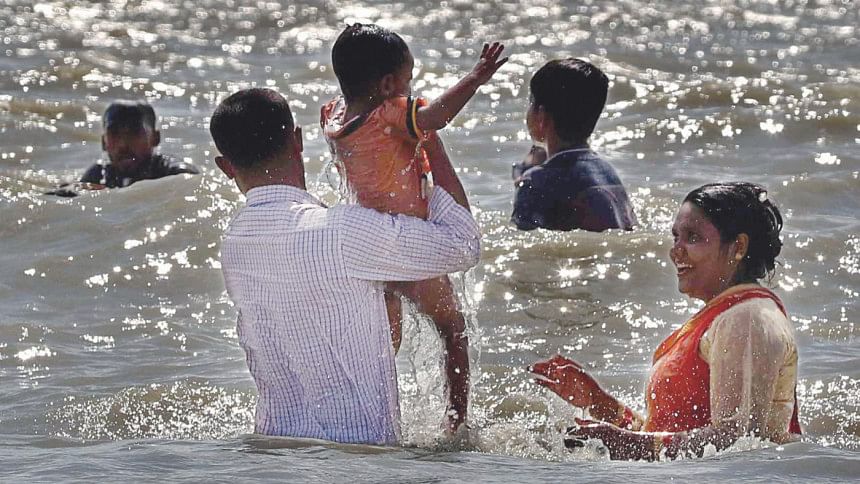A silent cry for help

Partho, 8, went missing for two days in early November until his body was found at the shore of a river in his village, Aburkandi, Chandpur. He was last seen playing with his mates who all went back to their homes after dusk; only Partho did not return. Later, it was discovered that he died by slipping and drowning and none of his friends were aware of the situation. As daunting as it may seem, such scenarios are widespread across Bangladesh.
According to a report by International Drowning Research Centre Bangladesh (IDRC-B), drowning is the leading cause of death among children aged 1 to 17 in Bangladesh, with at least 18,000 deaths per year, killing approximately 50 children every day; children aged 1 to 4 are at increased risk of drowning. The report further states that water bodies such as ponds and ditches are abundant in Bangladesh and many essential activities such as bathing, cooking, agriculture, etc., heavily involve working near water bodies, mostly in rural areas. Also, children of various age groups tend to play near water bodies. Such practices naturally increase the likelihood of death of children by drowning. Moreover, for children aged five and under, over 80 percent of fatal drowning incidents occur in closed vessels, ditches and ponds, usually less than 20 metres away from their homes. Whilst for children over five, drowning occurs farther away from their homes, usually when swimming without adult supervision.
Esha Husain, Partnership Lead, Synergos Consulting Services, shares, “Drowning is the leading cause of death for children aged 1-4 which happens within 20 metres of home, more so in rural areas, when children are left unsupervised, as their mothers are busy with household chores or are away for work.”
To tackle the crisis, drowning prevention activities are increasing in Bangladesh, with support from organisations such as Philanthropies Initiative to Prevent Drowning, UNICEF in Bangladesh, Save the Children International Bangladesh, Bangladesh Early Childhood Development Network, IDRC-B, to name a few.
Esha adds, “Daycares can cater to a gamut of child care and development needs, including early learning, heath, nutritional development, early screening of disability, among others. Currently, most of the early childhood care or daycare centres in the country are implemented by non-government agencies. However, due to the decreasing trend of external donor funds, a lot of sectors including child development and care run the risk of fund crunch.” Esha further states, “The development practitioners envisage that in a middle-income country such as ours, the government investment in the child care sector need to increase and pilots or experimentations on integrated child care services should be initiated by the public sector before wider mainstreaming. The child care practitioners are waiting with bated breath for the Ministry of Women and Children Affairs to approve the Day Care Act which will necessitate and open doors for innovative interventions in both the public and private sectors.”
Traditional first aid practices when a child drowns include laying down the child’s body in a straight position and rubbing it with ashes or salt as it helps absorb water and provides warmth to the body. Foods such as rotten banana leaves, uncooked eggs and arum stems can also be fed to make the child puke out the water. However, IDRC-B suggests that such practices may endanger children’s lives more.
In 2016, Bloomberg Philanthropies supported daycare centres across seven sub-districts, known as “Anchals”, where an “Anchal Ma” is appointed to take care of children when their parents are away for other work, as a part of a research study to see if this initiative can help reduce drowning of children. The initiative successfully made a lasting impact, preventing drowning of more than 70,000 children aged 1 to 4, besides providing training for social and cognitive development. Support from the government is needed currently to take this initiative forward.
Currently, Royal National Lifeboats Institution (RNLI) along with Center for Injury Prevention and Research Bangladesh (CIPRB) and the George Institute for Global Health have launched Project BHASHA, which is working to reduce the rate of drowning in Barishal division, where the drowning epidemic is three times higher. They are providing SwimSafe lessons and Anchal to communities in Barishal. This helps children remain engaged in playing and learning as a part of pre-school preparation, while their parents are away, thereby reducing cases of drowning.
Esha states, “A National Drowning Prevention Strategy is still awaiting approval from the Ministry of Health and Family Welfare. Also, news reporting on drowning incidence is in small letters. Similarly, number of initiatives on drowning prevention is not significant compared to its scale. Increased awareness, incentives for organisations willing to help, contribution of the government and aligned guidelines are all elements which are essential in rectifying this grave concern of child drowning in Bangladesh.”

 For all latest news, follow The Daily Star's Google News channel.
For all latest news, follow The Daily Star's Google News channel. 



Comments